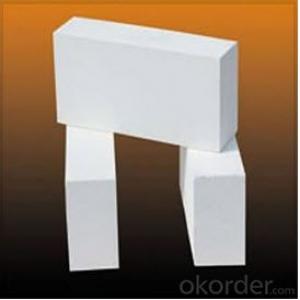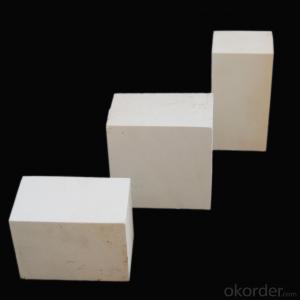High Alumina Brick for Blast Furnace
- Loading Port:
- Qingdao
- Payment Terms:
- TT OR LC
- Min Order Qty:
- 2 m.t
- Supply Capability:
- 5000 m.t/month
OKorder Service Pledge
OKorder Financial Service
You Might Also Like
Brief discription for High Alumina Bricks for blast furnace
CMAX High Alumina Bricks for blast furnace are classified according to alumina content ranging from 48% to 90%.
CMAX High Alumina Bricks for blast furnace are commonly used in blast furnace, hot blast furnace, the roof of electric furnace, teeming ladle, rotary kiln,regenerator, etc.
Brief features for High Alumina Bricks for glass industry
◆Low thermal conductivity
◆Excellent acid and base slagging resistance
◆High refractoriness
◆Excellent thermal shock resistance
◆Excellent mechanical strength
◆Good spalling resistance and wear resistance.
◆Good corrosion resistance.
◆High-temperature creep rate is quite low.
◆Good volume stability at high temperature.
◆Low bulk density, low thermal conductivity, good thermal insulation performance.
Technical data for High Alumina Bricks for blast furnace
ITEM | UAL48 | UAL55 | UAL65 | UAL75 | UAL80 | UAL85 | ALP80 |
Refractoriness, ℃ | 1750 | 1770 | 1790 | 1790 | 1810 | 1810 | 1810 |
Apparent Porosity,% | 22 | 22 | 23 | 23 | 20 | 20 | 18 |
C.C.S, Mpa | 39 | 44 | 49 | 53 | 55 | 60 | 100 |
Refractories Under Load (0.2Mpa),℃ | 1420 | 1470 | 1500 | 1520 | 1500 | 1520 | 1550 |
Reheating Linear Change,% | 1450℃x2h 0.1~-0.4 | 1500℃x2h 0.1~-0.4 | 1500℃x2h 0.1~-0.4 | 1500℃x2h 0.1~-0.4 | 1550℃x2h -0.5~+0.5 | 1550℃x2h -0.5~+0.5 | 1550℃x2h -0.5~+0.5 |
Al2O3 Content , % | 48 | 55 | 65 | 75 | 80 | 85 | 82 |
FAQ
Q1:Are you a manufacture or trader?
A:Factory+trade(mainly factories,at the same time,we operates other related products).
Q2:Can we visit your factory?
A:Sure,welcome at any time,seeing is believing.
Q3:What's the MOQ of trial order?
A:No limit,We can offer the best suggestions and solutions according to your condition.
Q4:Which payment terms can you accept?
A:T/T,L/C are available for us.
Q5:After an order is confirmed,when to deliver?
A:15-25days after deposit.
Q6:Is your company accept customization?
A:We have own factory and excellent technical team,and we accept OEM service.
- Q: What are the high aluminum bricks made of?
- It's OK to use corundum bricks and alumina hollow ball bricks to build a furnace,
- Q: What are the specific raw materials for plastic pallets?
- There are two kinds of raw materials for plastic pallets: one is polypropylene (PP) and the other is polyethylene (HDPE).Plastic pallets for logistics storage: pp+pe material, recycled material 10%;Plastic trays for food trays: food grade PP, PE, pc;Polyethylene (HDPE) has excellent impact resistance and cold resistance, and it can resist environmental stress cracking. Excellent chemical stability, good oil resistance. Water absorption and tiny, low permeability, organic vapor transmission rate is larger. Electrical insulation is good, in all frequency range, dielectric properties are extremely excellent.
- Q: What is the standard classification of high alumina bricks and high alumina bricks?
- Refractory brick is non-metallic materials can be classified according to a kind of inorganic material, high aluminum brick, clay brick, magnesia brick, corundum brick, mullite bricks, silicon carbide materials such as brick, high alumina brick is used as a relatively wide range of products in accordance with the refractory brick high alumina refractory materials by high aluminum brick is generally divided into Al2O3 content three: I - II - >75% Al2O3 content; the content of Al2O3 is 60 ~ 75%; III - Al2O3 content from 48 to 60%.
- Q: What's the difference between a well type annealing furnace and a box type annealing furnace?
- Box annealing furnace application: mainly used for quenching, normalizing, annealing and other conventional heat treatment equipment for steel parts. Features: 1, electric loading, high productivity, heat treatment is especially suitable for small and medium-sized parts, such as 30%, uniform temperature, intelligent digital display meter PID (pictured) automatic temperature control, high precision; 2, electric discharge loading convenient, as good; 3, door and seal the oven body is sealed automatically, without manual seal; 4, equipped with electric interlock protection device, and can prevent the fault accident due to the error. Bell type annealing furnace four bell type annealing furnace bell type annealing furnace is mainly used for annealing sheet metal in natural atmosphere and normalizing treatment of steel parts. 1, special steel, precision alloy large all fiber trolley type resistance furnace, strip, wire bright annealing. 2 、 annealing of special steel casting and forging. 3. Annealing of silicon steel sheet. 4, metal and non metal powder sintering pieces etc..
- Q: Density of high alumina bricks
- Alumina content of 48% or more, mainly from mullite and glass phase or corundum composition of lightweight refractory. The volume density is 0.4 ~ 1.35g/cm3. The porosity is 66% ~ 73%, and the compressive strength is 1 ~ 8MPa. Better thermal shock resistance.
- Q: What are the common thermal insulation materials for thermal conductivity?
- Aerogels are known to be the lightest solid materials in the world. It is made of nanometer silica aerogel as main material and is compounded by special process. The utility model has the advantages of high temperature resistance, low thermal conductivity, small density, high strength, green environment protection, waterproof and non inflammable performance. At the same time, with excellent sound insulation and shock absorption performance, it is now widely used in metallurgy, chemical, national defense, aerospace and other fields, is an indispensable high-performance insulation materials.
- Q: What are the requirements for refractory materials in heat treatment furnace?
- Fire resistance is an important performance index of refractory materials, but it does not represent the highest temperature in actual use of refractory materials. In actual use, refractories also bear certain pressure, therefore, must consider the high strength at high temperature refractory material, which is in high temperature under certain pressure without deformation, such as the NZ-40 refractory refractory degree up to 1730 DEG C, but the maximum temperature is only 1350 degrees celsius.
- Q: What is the apparent porosity of high alumina brick?
- Total porosity is porosity refers to the total volume of sample porosity in the percentage of total volume of samples. Apparent porosity refers to the percentage of the total volume of openings, pores, and total specimens in the sample.
- Q: How to reduce the harm caused by two times mullite in high alumina refractory material
- Two times mullite refers to the content of aluminum is about 70%, in high temperature sintering, the expansion coefficient is large, the thermal expansion rate is high.
- Q: High alumina brick 80 with which high aluminum cement?
- Which kind should be chosen should be determined according to the conditions of use, life expectancy and cost control. By the way, the quality of masonry is also very influential.
Send your message to us
High Alumina Brick for Blast Furnace
- Loading Port:
- Qingdao
- Payment Terms:
- TT OR LC
- Min Order Qty:
- 2 m.t
- Supply Capability:
- 5000 m.t/month
OKorder Service Pledge
OKorder Financial Service
Similar products
Hot products
Hot Searches
Related keywords
































